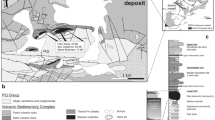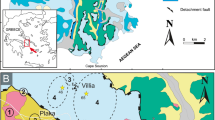Abstract
Quantitative microanalysis of entire silicate and sulfide melt inclusions by Excimer Laser-ablation inductively-coupled-plasma mass-spectrometry (LA-ICPMS) has been applied to extrusive and shallow intrusive rocks from the andesitic Farallón Negro Volcanic Complex (northwestern Argentina). Silicate melts are trapped in pyroxene, amphibole, plagioclase and quartz, and sulfide melts are trapped in amphibole. Details of the analytical approach and the quantification procedure are given and the results are evaluated to test the accuracy of the technique and the validity of the interpretation of analytical signals. Similar compositions of silicate melt inclusions trapped in truly co-precipitating minerals show that the quantification approach of melt inclusion compositions from LA-ICPMS signals through an internal standard is valid. This correspondence also shows that melt inclusions investigated in this study are not significantly influenced by the boundary layer around a growing crystal or by post-entrapment modifications. Post-entrapment diffusive re-equilibration only affected the Fe and Mg content of melt inclusions in mafic phases. Thus, melt inclusions are representative samples of the melt from which the host mineral crystallized, with regard to most major and trace elements. Sulfide melt inclusions (present as pyrrhotite with exsolution of Au and Cu in phases separated during cooling) were analyzed for their bulk Fe, Cu and Au content, and the abundance of these elements was quantified using a silicate glass as external standard. The validity of this calibration was tested by comparing electron microprobe analyses of Fe, Cu, Ni and Co in homogeneous sulfide minerals with LA-ICPMS results. Identical results within calculated uncertainty (one standard deviation of five to nine analyses, mostly between 1 and 5 wt% RSD) demonstrate that for these elements, measured element ratios are independent of the matrix using our analytical setup.








Similar content being viewed by others
References
Alard O, Griffin WL, Lorand JP, Jackson SE, O’Reilly SY (2000) Non-chondritic distribution of the highly siderophile elements in mantle sulphides. Nature 407:891–894
Anderson AT, Brown GG (1993) CO2 contents and formation pressures of some Kilauean melt inclusions. Am Miner 78:794–803
Campos E, Touret JLR, Nikogosian I, Delgado J (2002) Overheated, Cu-bearing magmas in the Zaldivar porphyry-Cu deposit, Northern Chile. Geodynamic consequences. Tectonophysics 345:229–251
Danyushevsky LV, McNeill AW, Sobolev AV (2002a) Experimental and petrological studies of melt inclusions in phenocrysts from mantle-derived magmas: an overview of techniques, advantages and complications. Chem Geol 183:5–24
Danyushevsky LV, Sokolov S, Falloon TJ (2002b) Melt inclusions in olivine phenocrysts: using diffusive re- equilibration to determine the cooling history of a crystal, with implications for the origin of olivine-phyric volcanic rocks. J Petrol 43:1651–1671
Dietrich A, Lehmann B, Wallianos A (2000) Bulk rock and melt inclusion geochemistry of Bolivian tin porphyry systems. Econ Geol Bull Soc Econ Geol 95:313–326
Fryer BJ, Jackson SE, Longerich HP (1995) Design, operation and role of the laser-ablation microprobe coupled with an inductively-coupled plasma—mass-spectrometer (Lam-Icp-Ms) in the earth-sciences. Can Mineral 33:303–312
Gaetani GA, Watson EB (2000) Open system behavior of olivine-hosted melt inclusions. Earth Planet Sci Lett 183:27–41
Gunther D, Frischknecht R, Heinrich CA, Kahlert HJ (1997) Capabilities of an Argon Fluoride 193 nm excimer laser for laser ablation inductively coupled plasma mass spectrometry microanalysis of geological materials. J Anal At Spectrom 12:939–944
Halter WE, Pettke T, Heinrich CA (2002a) The origin of Cu/Au ratios in porphyry-type ore deposits. Science 296:1844–1846
Halter WE, Pettke T, Heinrich CA, Rothen-Rutishauser B (2002b) Major to trace element analysis of melt inclusions by laser- ablation ICP-MS: methods of quantification. Chem Geol 183:63–86
Halter WE, Bain N, Becker K, Heinrich CA, Landtwing M, VonQuadt A, Bissig T, Clark AH, Sasso AM, Tosdal RM (2004a) From andesitic volcanism to the formation of a porphyry-Cu-Au mineralizing magma chamber: The Farallón Negro Volcanic Complex, northwestern Argentina. J Volcanol Geotherm Res (in press)
Halter WE, Heinrich CA, Pettke T (2004b) Laser-ablation ICP-MS analysis of melt inclusions in an andesitic complex II: Magmas genesis and implications for ore-formation. Contrib Mineral Petrol (in press)
Hauri E, Wang JH, Dixon JE, King PL, Mandeville C, Newman S (2002) SIMS analysis of volatiles in silicate glasses 1. Calibration, matrix effects and comparisons with FTIR. Chem Geol 183:99–114
Heinrich CA, Pettke T, Halter WE, Aigner M, Audétat A, Günther D, Hattendorf B, Bleiner D, Guillong M, Horn I (2002) Quantitative multi-element analysis of minerals, fluid and melt inclusions by Laser-Ablation Inductively-Coupled-Plasma Mass-Spectrometry. Geochim Cosmochim Acta (in press)
Jackson SE, Longerich HP, Dunning GR, Fryer BJ (1992) The application of laser-ablation microprobe—inductively coupled plasma—mass-spectrometry (LAM-ICP-MS) to in situ trace-element determinations in minerals. Can Mineral 30:1049–1064
Kamenetsky V, Clocchiatti R (1996) Primitive magmatism of Mt Etna: Insights from mineralogy and melt inclusions. Earth Planet Sci Lett 142:553–572
Kamenetsky VS, Eggins SM, Crawford AJ, Green DH, Gasparon M, Falloon TJ (1998) Calcic melt inclusions in primitive olivine at 43 degrees N MAR: evidence for melt-rock reaction/melting involving clinopyroxene-rich lithologies during MORB generation. Earth Planet Sci Lett 160:115–132
Larocque ACL, Stimac JA, Keith JD, Huminicki MAE (2000) Evidence for open-system behavior in immiscible Fe-S-O liquids in silicate magmas: Implications for contributions of metals and sulfur to ore-forming fluids. Can Mineral 38:1233–1249
Llambías EJ (1970) Geologia de los Yacimientos Mineros Agua de Dionisio, Prov. de Catamarca, Rep. Argentina. Revista de la Asociacion Argentina de Mineralogia Petrologia y Sedimentologia 1:2–32
Longerich HP, Gunther D, Jackson SE (1996) Elemental fractionation in laser ablation inductively coupled plasma mass spectrometry. Fresenius J Anal Chem 355:538–542
Lowenstern JB (1994) Dissolved volatile concentrations in an ore-forming magma. Geology 22:893–896
Metrich N, Clocchiatti R, Mosbah M, Chaussidon M (1993) The 1989–1990 activity of Etna magma mingling and ascent of H2O-Cl-S-rich basaltic magma—evidence from melt inclusions. J Volcanol Geotherm Res 59:131–144
Pettke T, Heinrich CA, Ciocan AC, Gunther D (2000) Quadrupole mass spectrometry and optical emission spectroscopy: detection capabilities and representative sampling of short transient signals from laser-ablation. J Anal At Spectrom 15:1149–1155
Pettke T, Webster JD, Halter WE, Heinrich CA, Aigner-Torres M, De Vivo B (2002) Advantages and limitations of quantifying melt inclusion chemistry by LA-ICPMS, EMP and SIMS. Geochim Cosmochim Acta 66:A596–A596
Roedder E (1984) Fluid inclusions. Rev Miner, 12. Mineral Soc Am Wash, 644 pp
Sisson TW, Grove TL (1993) Experimental investigations of the role of H2O in calc-alkaline differentiation and subduction zone magmatism. Contrib Mineral Petrol 113:143–166
Sobolev AV (1996) Melt inclusions in minerals as a source of principle petrological information. Petrology 4:209–220
Sobolev AV, Chaussidon M (1996) H2O concentrations in primary melts from supra-subduction zones and mid-ocean ridges: Implications for H2O storage and recycling in the mantle. Earth Planet Sci Lett 137:45–55
Sobolev AV, Dmitriev LV, Barsukov VL, Nevsorov VN, Slutsky AB (1980) The formation conditions of the high magnesium olivines from the monomineralic fraction of Luna 24 regolith. In: PR Criswell, Merrill RB (eds) Igneous processes and remote sensing: Proceedings of the Lunar and Planetary Science Conference, 11. (vol) 1, Pergamon, New York, pp 105–116
Sobolev AV, Shimizu N (1993) Ultra-depleted primary melt included in an olivine from the Mid-Atlantic Ridge. Nature 363:151–154
Sylvester P (2001) A practical guide to platinum-group element analysis of sulphides by laser-ablation ICPMS. In: Sylvester P (ed) Laser-ablation in the earth sciences: principles and application. Mineral Assoc Can 29:203–213
Taylor RP, Jackson SE, Longerich HP, Webster JD (1997) In situ trace-element analysis of individual silicate melt inclusions by laser ablation microprobe inductively coupled plasma-mass spectrometry (LAM-ICP-MS). Geochim Cosmochim Acta 61:2559–2567
Thomas JB, Bodnar RJ, Shimizu N, Chesner C (2002) What boundary layer? Evidence from melt inclusions in plagioclase, quartz, allanite and zircon from the Toba Tuffs, Sumatra, Indonesia. In: Kontak DJ, Anderson AJ (eds), Eighth Biennial Pan-American Conference on Research on Fluid Inclusions, Halifax, Nova Scotia, pp 103–104
Wallace PJ, Anderson AT, Davis AM (1995) Quantification of pre-eruptive exsolved gas contents in silicic magmas. Nature 377:612–616
Webster JD, Kinzler RJ, Mathez EA (1999) Chloride and water solubility in basalt and andesite melts and implications for magmatic degassing. Geochim Cosmochim Acta 63:729–738
Acknowledgments
The authors would like to thank Minera Alumbrera Ltd. and MIM Exploration for their logistic support during the fieldwork required by this study. Many thanks also go to Tim Grove for extensive discussions of the data and his insight into magmatic systems. We would also like to acknowledge the constructive reviews by Eric Christiansen, Katherine Kelly and Charles Mandeville.
Author information
Authors and Affiliations
Corresponding author
Additional information
Editorial responsibility: T.L. Grove
Rights and permissions
About this article
Cite this article
Halter, W.E., Pettke, T. & Heinrich, C.A. Laser-ablation ICP-MS analysis of silicate and sulfide melt inclusions in an andesitic complex I: analytical approach and data evaluation. Contrib Mineral Petrol 147, 385–396 (2004). https://doi.org/10.1007/s00410-004-0562-6
Received:
Accepted:
Published:
Issue Date:
DOI: https://doi.org/10.1007/s00410-004-0562-6




